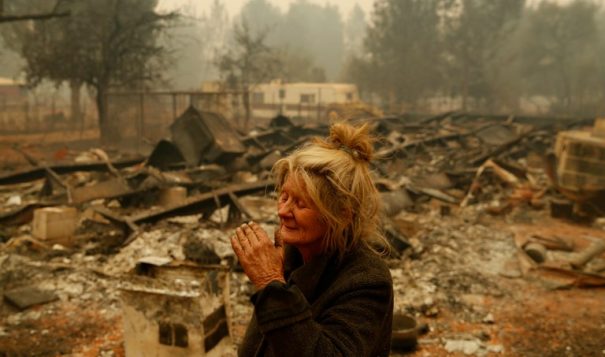 Vulnerable populations such as the elderly face heightened barriers to recovery when fire devastation hits. Paradise, California, resident Cathy Fallon reacts as she stands near the charred remains of her home.
John Locher/AP Images
Vulnerable populations such as the elderly face heightened barriers to recovery when fire devastation hits. Paradise, California, resident Cathy Fallon reacts as she stands near the charred remains of her home.
John Locher/AP Images
High Country News
Resilience depends on economics and history as much as fuel.
As of this writing, 79 people have died and several hundred are still missing from northern California’s deadly Camp Fire. Yet even as Californians work to rebuild their lives, Westerners know the next devastating conflagration is only a matter of time.
Increasing numbers of Westerners live in fire-prone areas. But as Westerners think about how to prepare for future fires, new research suggests that the answer isn’t as simple as avoiding flammable homesites. While it’s tempting to think of wildfire risk in terms of geography — fuel loads, lightning frequency, forest types — the reality is more complex. Writing in the academic journal PLOS One, researchers explained that for people living in wildfire-prone areas, the real causes of devastation come from socioeconomic and historical, not landscape, factors.
According to the research, most Americans living in areas at the highest risk from wildfires are affluent, sometimes owning second homes in the wildland-urban interface, or WUI. But these aren’t necessarily the most wildfire vulnerable Americans.
Roughly 40 percent of Americans living in wildfire-prone areas, or about 12 million people, lack the resources to prepare for or recover from fire. In general, the study found that the elderly, disabled and non-English-speaking are more likely to be devastated by a fire.
One reason is that cheaper housing, such as mobile homes or apartments, is often less durable during fires, and poorer Americans are less likely to have reliable transportation during an emergency. After a burn, renters don’t qualify for as much federal assistance as property owners. As well, the researchers point out that in the aftermath of the 2017’s Sonoma County fires in California, rental prices shot up, hurting lower income residents.
In contrast, wealthy homeowners are more likely to have the funds to prepare for fires, such as by paying for flammable plant growth to be thinned near homes, and have access to educational materials about wildfire preparedness. They also are more likely to have the benefits of home ownership in a fire’s aftermath that renters lack, such as fire insurance. In other words, lower income residents of less-fire-prone areas may still be more fire vulnerable than wealthy residents of more-fire-prone areas.
Vulnerability is a complex mix of economics, place-based history, and culture. For lower-income residents of fire-prone areas, access to transportation, or even just information, can be limited. “If you don’t have a cell phone and everybody’s getting evacuation orders by cellphone or social media … you end up being part of the disaster,” said Phillip Levin, a conservation scientist at the University of Washington and study coauthor. Additionally, during California’s devastating 2017 fires, emergency departments and radio stations struggled to release correct and timely Spanish-language information.
And there are historical barriers to fire resiliency, Levin said. By far, the most fire vulnerable communities in the West are tribal nations. These patterns of resources and of resilience fit into larger historical realities: While wealthy Americans who are white or Asian American are less likely to live in fire vulnerable communities, Native Americans, regardless of income, are vastly overrepresented in regions that are both fire-prone and fire-vulnerable.
Levin also works with The Nature Conservancy, where he keeps community resilience in mind during wildfire management projects, such as by hiring locally for forest thinning crews. “We can invest economically in a community with jobs, with other financial opportunities, with other programs that help mitigate some of those vulnerability factors,” he said.
“When [a fire] hits, it’s always tragic,” Levin added. “But as we think and plan, there are ways we can help make everybody safer.”
Maya L. Kapoor is an associate editor at High Country News. Email her at mayak@hcn.org.

